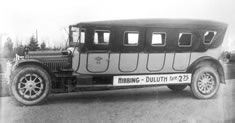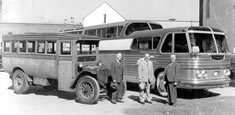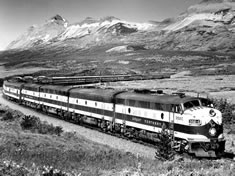For decades, intercity bus and rail provided the only means of traversing the district's expanses without a private car. Greyhound, founded in 1914 in Hibbing, Minn., has long been an icon of rural mobility. James J. Hill's Great Northern Railway brought settlers to the Great Plains and carried soldiers off to two world wars. But the continued viability of intercity bus and rail service in rural areas is in doubt. Neither would serve dozens of small towns in the district without federal subsidies. Long-distance bus service has declined over time in the district, as Greyhound and other bus companies have eliminated routes and stops and reduced the frequency of service. Reeling from losses of $140 million in 2002 and 2003, Greyhound eliminated dozens of stops in the six district states last August. Abandoned routes included Fargo to Billings, Minneapolis to Grand Forks and Green Bay to Minocqua, Wis. Other routes, such as Minneapolis to Duluth, became express routes, bypassing small towns along the way. |
Mesaba Transportation, circa 1920
Greyhound buses from 1916
The Empire Builder, 1955 |
Competing intercity carriers such as Minneapolis-based Jefferson Bus Lines and Rimrock Stages Trailways of Billings took over most of the dropped or pared-down routes. But many intercity bus routes in the district—among them well-established routes plied by regional carriers as well as those salvaged from Greyhound—remain perennial money losers, subsisting only at the pleasure of the federal government.
Jefferson agreed to take over the Minneapolis-Duluth and Minneapolis-Madison routes only after the Minnesota and Wisconsin departments of transportation pledged a total of $117,500 to help defray operating costs through the end of 2004. State support was expected to continue in 2005. The money came from a Federal Transit Administration (FTA) program that covers half of a carrier's operating losses on routes with low ridership.
Last November an average of 13 passengers rode the 316 miles from Minneapolis to Madison each day, not nearly enough for Jefferson to break even on a $62 one-way ticket. "We would definitely not run these routes without subsidy," said Jefferson President Charlie Zelle. "If we did we would be unprofitable." The privately held company made a small profit on $20 million in revenues last year.
Rimrock CEO Tom Forseth prefers the term "operating assistance" to describe the $300,000 in FTA funds his company received in 2004. Last fall Rimrock was making a profit on the Fargo-Billings route it acquired from Greyhound but still losing money on Montana routes it has operated for years, including Billings-Great Falls and Missoula-Whitefish. Overall, Rimrock's ridership has fallen 10 percent to 15 percent over the last five years. Forseth attributes the decline to lingering economic malaise (people traveling less and taking shorter trips) and more Montanans opting to drive because of improved highways and milder, less snowy winters.
As for Amtrak, the financial woes of the country's sole surviving long-distance passenger railroad are well documented. Over the past 25 years, Amtrak has cut routes in the Midwest and threatened to cut more whenever Congress has balked at covering its operating losses. It will likely have to again, given the Bush administration's proposal to eliminate federal funding for Amtrak.
Nationwide, Amtrak ridership has risen about 25 percent since 1997, and the Empire Builder carries the most passengers of all the company's long-distance routes—over 437,000 in fiscal 2004, a 5.2 percent increase over the previous year. But ridership would have to skyrocket on the Empire Builder and Amtrak's other long-haul routes to offset the railroad's high costs. In 2004, passenger and mail revenues covered only 61 percent of the company's operating expenses, leaving a $1.2 billion deficit that Congress was obliged to erase with subsidies. That means that taxpayers are subsidizing Amtrak to the tune of $48 per passenger.
Return to: Missing the bus








